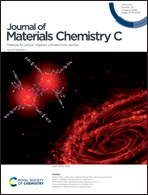van der Waals integration of AZO/MoS2 ohmic junctions toward high-performance transparent 2D electronics†
Abstract
Two-dimensional (2D) semiconductors have the potential to revolutionize future electronics. However, large Schottky barriers exist between 2D semiconductors and metals due to the Fermi level pinning effect, which seriously limits their applications. Here, we demonstrate ohmic contacts to MoS2 by utilizing transparent ZnO:Al (AZO) conductors without forming any contact barriers. Benefiting from the creation of a van der Waals junction in which the atomic precursors react with the physically adsorbed H2O on the MoS2 surface, a nondestructive interface between AZO and MoS2 can be made without any interfacial chemical interactions and disorder. An ideal AZO–MoS2 ohmic junction, which overcomes the Schottky–Mott limit, is achieved by work function matching for the first time. More importantly, this ideal ohmic junction, to our knowledge, yields so far the highest mobility (26.9 cm2 V−1 s−1), fastest switching speed (0.07 V dec−1) and largest optical average transmittance (nearly 90% throughout the visible range) for monolayer MoS2 (grown by chemical vapor deposition) transistors. Thus, our study not only experimentally validates an ideal metal–semiconductor ohmic contact, but also provides a novel material integration method to fabricate high-performance transparent 2D electronic devices.



 Please wait while we load your content...
Please wait while we load your content...